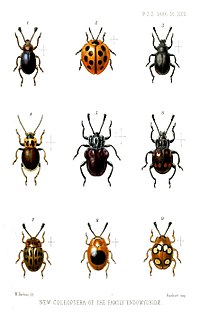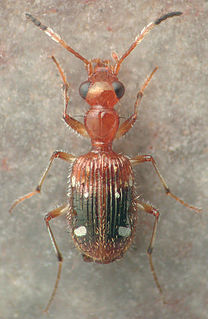Related Research Articles

Tiger beetles are a large group of beetles, from the Cicindelinae subfamily, known for their aggressive predatory habits and running speed. The fastest known species of tiger beetle, Cicindela hudsoni, can run at a speed of 9 km/h, or about 125 body lengths per second. As of 2005, about 2,600 species and subspecies were known, with the richest diversity in the Oriental (Indo-Malayan) region, followed by the Neotropics.

Rhantus is a genus of beetle in family Dytiscidae. There are about 100 species distributed worldwide. They often live in pools and marshy habitat types. Several species have colonized oceanic islands and become endemics.

Melyridae are a family of beetles of the superfamily Cleroidea.

Pterostichus is a very large genus of ground beetles with a Holarctic distribution in the subfamily Harpalinae. It has over 1,100 species. The beetles are predatory, but sometimes feed on strawberries. They can be found under rocks and prefer slightly moist, sandy soil although preferences differ between species. Pterostichus contains the following species:

Endomychidae, or handsome fungus beetles, is a family of beetles with representatives found in all biogeographic realms. There are around 120 genera and 1300 species. The family was established based on the type genus Endomychus, a genus erected in 1795 by Panzer which was applied to a species that Linnaeus called Chrysomela coccinea. As the common name suggests, Endomychidae feed on fungi. Crowson, in his influential treatment of the beetles, placed the family within the Cucujoidea. They have a tarsal formal of 4-4-4 or 3-3-3 and the wings lack a closed radial cell. The second antennal segment has a sensory appendage that is as long as the third antennal segment. The family has also been grouped with the Coccinellidae in a group called the Trimera for having pseudotrimerous tarsi. A 2015 molecular phylogeny study found that the Cucujoidea were found to be non-monophyletic and the Endomychidae was refined with the removal of the Anamorphinae from within the family and elevated to the status of a full family, Anamorphidae. Mycetaeinae and Eupsilobiinae were also found not to belong within the clades of the core Endomychidae, and likewise reclassified into the families Mycetaeidae and Eupsilobiidae.

Brachinus is a genus of ground beetle native to the Nearctic, Palearctic, the Near East and North Africa. Beetles in this genus are commonly referred to as bombardier beetles. The genus contains the following species:

Cymindis is a genus of ground beetle native to the Palearctic, the Near East, and North Africa. It contains the following species:

Lebia is a genus of predatory ground beetles. Common names include colorful foliage ground beetles and flat ground beetles. They are found worldwide and there over 700 species in 17 subgenera.

Lebiinae is a subfamily of beetles in the family Carabidae.

Calybe is a genus of beetles in the family Carabidae, containing the following species:

Pterostichinae is a subfamily of ground beetles. It belongs to the advanced harpaline assemblage, and if these are circumscribed sensu lato as a single subfamily, Pterostichinae are downranked to a tribe Pterostichini. However, as the former Pterostichitae supertribe of the Harpalinae as loosely circumscribed does seem to constitute a lineage rather distinct from Harpalus, its core group is here considered to be the present subfamily and the Harpalinae are defined more narrowly.
Diplous is a genus of beetles in the family Carabidae, containing the following species:

Dorcadion acutispinum is a species of beetle in the family Cerambycidae. It was described by Victor MotschulskyMotschulsky in 1860. It is known from Kazakhstan and China.
Dorcadion nitidum is a species of beetle in the family Cerambycidae. It was described by Victor Motschulsky in 1838. It is known from Turkey and Armenia.
Dorcadion septemlineatum is a species of beetle in the family Cerambycidae. It was described by Waltl in 1838. It is known from Turkey, and possibly Bulgaria and Greece.
Dorcadion kindermanni is a species of beetle in the family Cerambycidae. It was described by Waltl in 1838. It is known from Turkey.
Dorcadion glycyrrhizae is a species of beetle in the family Cerambycidae. It was described by Pallas in 1773.

Neoscytalidium dimidiatum was first described in 1933 as Hendersonula toruloidea from diseased orchard trees in Egypt. Decades later, it was determined to be a causative agent of human dermatomycosis-like infections and foot infections predominantly in the tropical areas; however the fungus is considered to be widespread. A newer name, Scytalidium dimidiatum, was applied to synanamorph of Nattrassia mangiferae, otherwise known as Neofusicoccum mangiferae. Substantial confusion has arisen in the literature on this fungus resulting from the use of multiple different names including: Torula dimidiata, Scytalidium dimidiatum, Fusicoccum dimidiatum, and Hendersonula toruloidea.

Cicindelini is a tribe of tiger beetles in the family Carabidae, containing the overwhelming majority of genera (>110) and species in the subfamily.
References
- ↑ "Dorcadion dimidiatum". BioLib. Retrieved 8 September 2014.